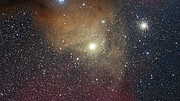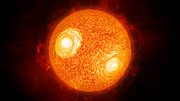VLTI velocity map of the surface of Antares
PR Image eso1726d
The bright red star Antares in the constellation of Scorpius
Videos
ESOcast 123 Light: Best Ever Image of a Star’s Surface and Atmosphere (4K UHD)
3D animation of Antares
ESOcast 123 Light: Best Ever Image of a Star’s Surface and Atmosphere (4K UHD)
3D animation of Antares
Approaching Antares (artist's impression)
First map of motion of material on a star other than the Sun
Using ESO’s Very Large Telescope
Interferometer astronomers have constructed the most detailed image ever
of a star — the red supergiant star Antares. They have also made the
first map of the velocities of material in the atmosphere of a star
other than the Sun, revealing unexpected turbulence in Antares’s huge
extended atmosphere. The results were published in the journal Nature.
To the unaided eye the famous, bright star Antares shines with a strong red tint in the heart of the constellation of Scorpius (The Scorpion). It is a huge and comparatively cool red supergiant star in the late stages of its life, on the way to becoming a supernova [1].
A team of astronomers, led by Keiichi Ohnaka, of the Universidad Católica del Norte in Chile, has now used ESO’s Very Large Telescope Interferometer (VLTI) at the Paranal Observatory
in Chile to map Antares’s surface and to measure the motions of the
surface material. This is the best image of the surface and atmosphere
of any star other than the Sun.
The VLTI is a unique facility that can combine the light from up to four telescopes, either the 8.2-metre Unit Telescopes, or the smaller Auxiliary Telescopes,
to create a virtual telescope equivalent to a single mirror up to 200
metres across. This allows it to resolve fine details far beyond what
can be seen with a single telescope alone.
“How stars like Antares lose mass so quickly in the final phase of their evolution has been a problem for over half a century,” said Keiichi Ohnaka, who is also the lead author of the paper. “The
VLTI is the only facility that can directly measure the gas motions in
the extended atmosphere of Antares — a crucial step towards clarifying
this problem. The next challenge is to identify what’s driving the
turbulent motions.”
Using the new results the team has created the first
two-dimensional velocity map of the atmosphere of a star other than the
Sun. They did this using the VLTI with three of the Auxiliary Telescopes and an instrument called AMBER
to make separate images of the surface of Antares over a small range of
infrared wavelengths. The team then used these data to calculate the
difference between the speed of the atmospheric gas at different
positions on the star and the average speed over the entire star [2].
This resulted in a map of the relative speed of the atmospheric gas
across the entire disc of Antares — the first ever created for a star
other than the Sun..
The astronomers found turbulent, low-density gas much
further from the star than predicted, and concluded that the movement
could not result from convection [3],
that is, from large-scale movement of matter which transfers energy
from the core to the outer atmosphere of many stars. They reason that a
new, currently unknown, process may be needed to explain these
movements in the extended atmospheres of red supergiants like Antares.
“In the future, this observing technique can be applied
to different types of stars to study their surfaces and atmospheres in
unprecedented detail. This has been limited to just the Sun up to now,” concludes Ohnaka. “Our work brings stellar astrophysics to a new dimension and opens an entirely new window to observe stars.”
Notes
[1] Antares is considered by astronomers to be a typical red
supergiant. These huge dying stars are formed with between nine and 40
times the mass of the Sun. When a star becomes a red supergiant, its
atmosphere extends outward so it becomes large and luminous, but
low-density. Antares now has a mass about 12 times that of the Sun and a
diameter about 700 times larger than the Sun’s. It is thought that it
started life with a mass more like 15 times that of the Sun, and has
shed three solar-masses of material during its life.
[2] The velocity of material towards or away from Earth can be measured by the Doppler Effect,
which shifts spectral lines either towards the red or blue ends of the
spectrum, depending on whether the material emitting or absorbing light
is receding from or approaching the observer.
[3] Convection is the process whereby
cold material moves downwards and hot material moves upwards in a
circular pattern. The process occurs on Earth in the atmosphere and
ocean currents, but it also moves gas around within stars.
More Information
Links
Contacts
Keiichi Ohnaka
Instituto de Astronomía — Universidad Católica del Norte
Antofagasta, Chile
Tel: +56 55 235 5493
Email: k1.ohnaka@gmail.com
Richard Hook
ESO Public Information Officer
Garching bei München, Germany
Tel: +49 89 3200 6655
Cell: +49 151 1537 3591
Email: rhook@eso.org
This research was presented in a paper entitled “Vigorous atmospheric
motion in the red supergiant star Antares”, by K. Ohnaka et al.,
published in the journal Nature.
The team is composed of K. Ohnaka (Universidad Católica del Norte,
Antofagasta, Chile), G. Weigelt (Max- Planck-Institut für
Radioastronomie, Bonn, Germany) and K. -H. Hofmann (Max- Planck-Institut
für Radioastronomie, Bonn, Germany).
ESO is the foremost intergovernmental astronomy organisation in
Europe and the world’s most productive ground-based astronomical
observatory by far. It is supported by 16 countries: Austria, Belgium,
Brazil, the Czech Republic, Denmark, France, Finland, Germany, Italy,
the Netherlands, Poland, Portugal, Spain, Sweden, Switzerland and the
United Kingdom, along with the host state of Chile. ESO carries out an
ambitious programme focused on the design, construction and operation of
powerful ground-based observing facilities enabling astronomers to make
important scientific discoveries. ESO also plays a leading role in
promoting and organising cooperation in astronomical research. ESO
operates three unique world-class observing sites in Chile: La Silla,
Paranal and Chajnantor. At Paranal, ESO operates the Very Large
Telescope and its world-leading Very Large Telescope Interferometer as
well as two survey telescopes, VISTA working in the infrared and the
visible-light VLT Survey Telescope. ESO is also a major partner in two
facilities on Chajnantor, APEX and ALMA, the largest astronomical
project in existence. And on Cerro Armazones, close to Paranal, ESO is
building the 39-metre Extremely Large Telescope, the ELT, which will
become “the world’s biggest eye on the sky”.
Links
Contacts
Keiichi Ohnaka
Instituto de Astronomía — Universidad Católica del Norte
Antofagasta, Chile
Tel: +56 55 235 5493
Email: k1.ohnaka@gmail.com
Richard Hook
ESO Public Information Officer
Garching bei München, Germany
Tel: +49 89 3200 6655
Cell: +49 151 1537 3591
Email: rhook@eso.org
Source: ESO/News







